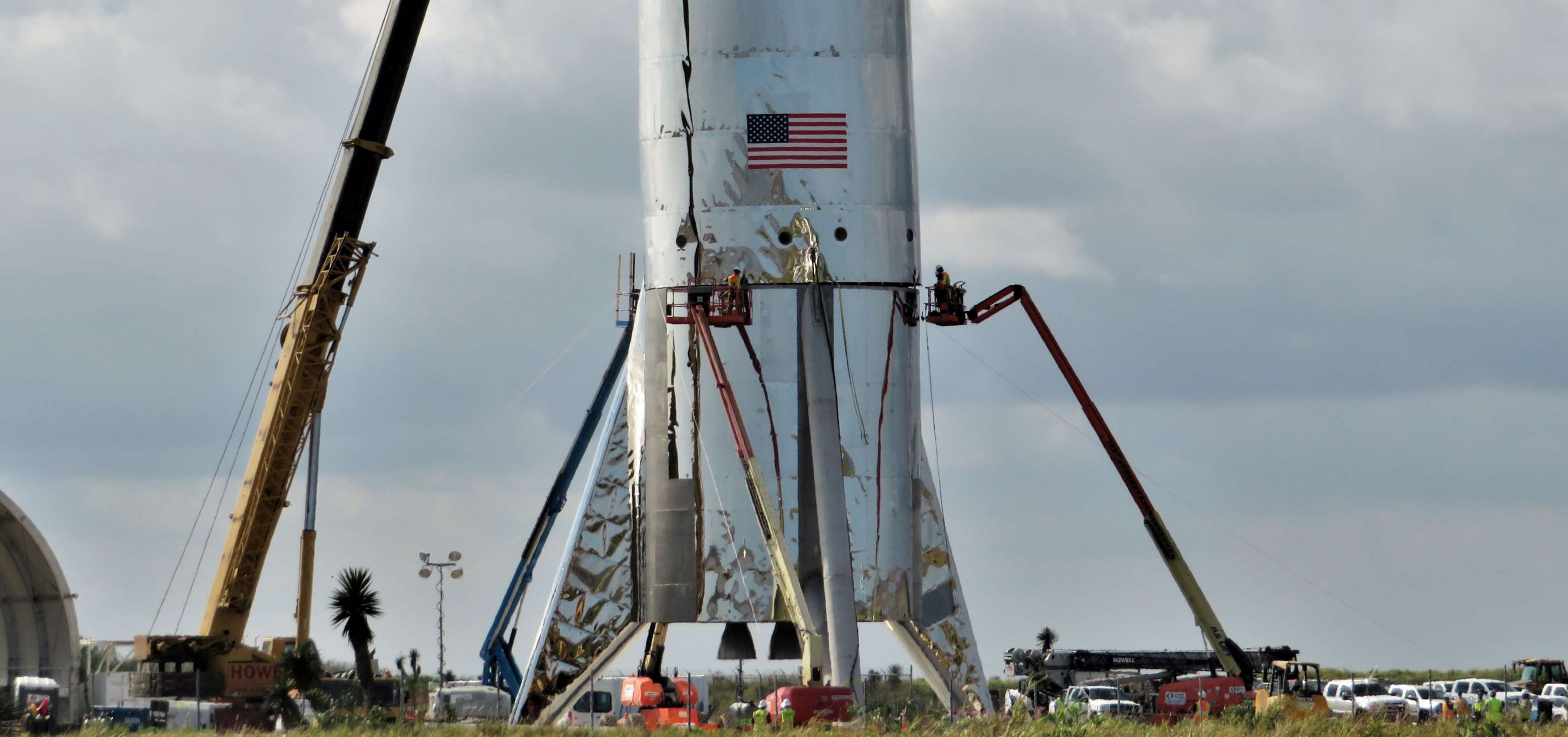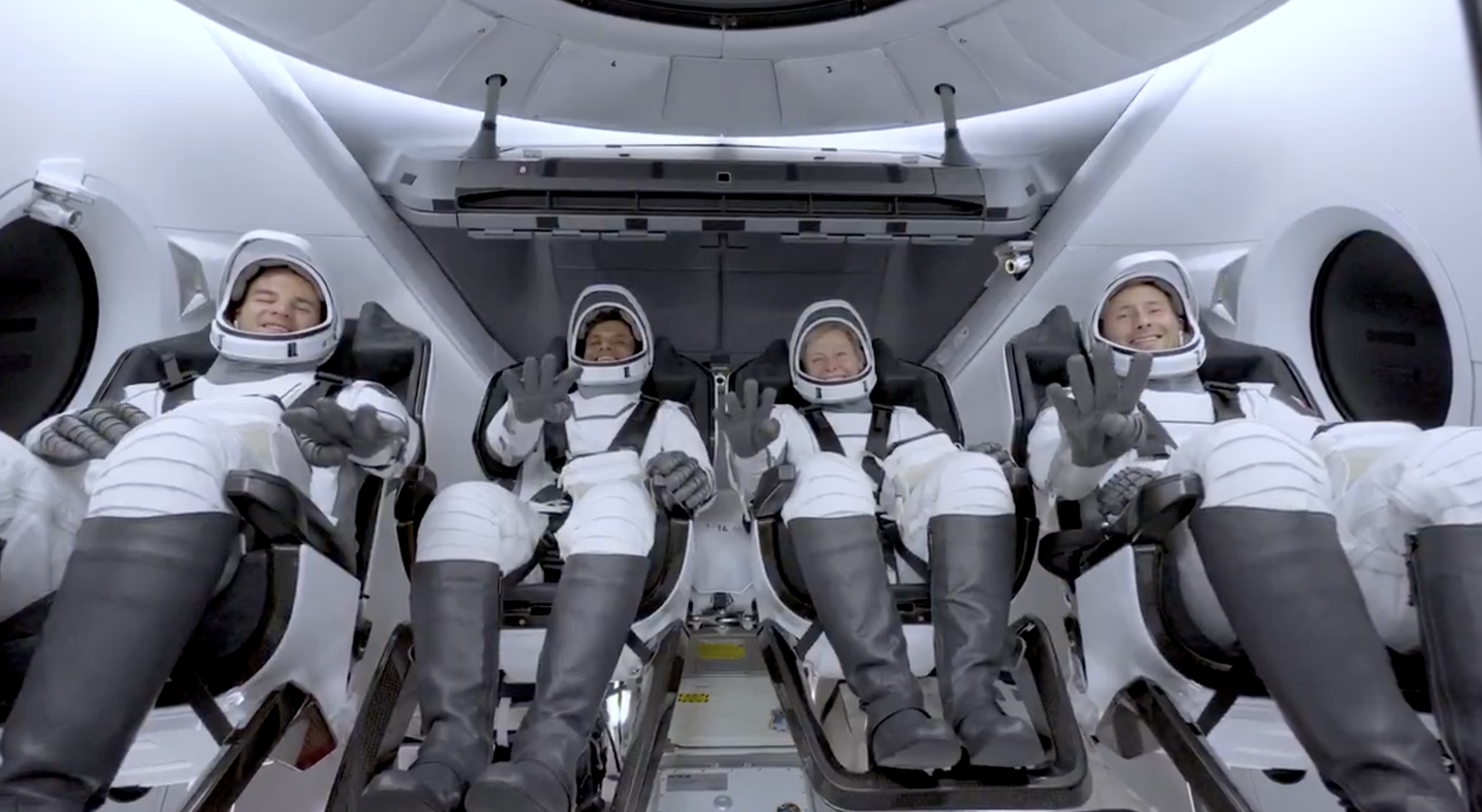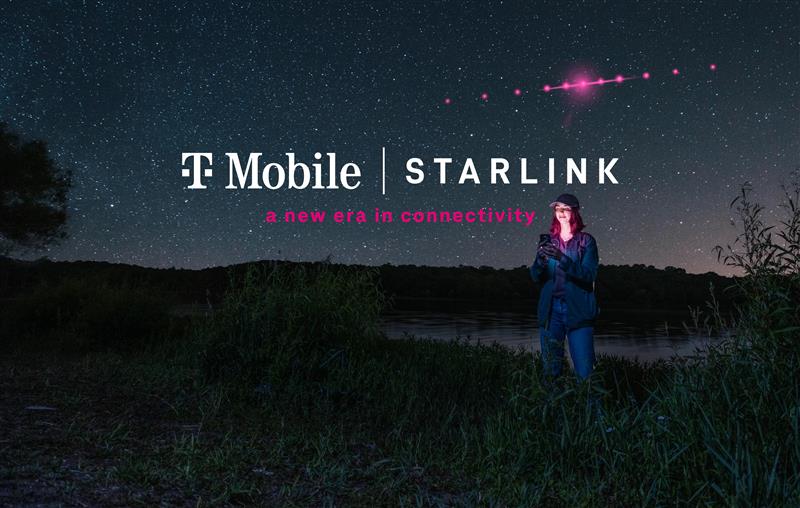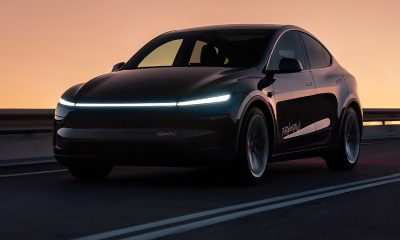

SpaceX
SpaceX’s Starship reaches new heights as Elon Musk teases Q1 2019 hop tests
In a burst of activity that should probably be expected at this point but still feels like a complete surprise, SpaceX technicians took a major step towards completing the first Starship hopper prototype by combining the last two remaining sections (aft and nose) scarcely six weeks after assembly began.
SpaceX CEO Elon Musk also took to Twitter late last week to offer additional details and post what appears to be the first official render of Starship’s hopper prototype, which is now closer than ever before to looking like the real deal thanks to the incredible drive of the company’s southernmost employees. With the massive rocket’s rough aeroshell and structure now more or less finalized, Musk’s targeted February/March hop test debut remains ambitious to the extreme but is now arguably far from impossible.
A quiet day as #SpaceX workers were having lunch and enjoying a well deserved break under the shadows of their creation. The wings/legs of the vehicle are getting an aesthetic touch up. 😍🚀 #Starshiphopper #ElonMusk #RGV pic.twitter.com/Y0zNGUNily
— Austin Barnard🚀 (@austinbarnard45) January 7, 2019
Where there was literally just a tent and some construction equipment barely eight weeks ago, SpaceX’s Boca Chica facilities now sport one of the most bizarre developments in recent aerospace history — a vast, ~30 ft (9m) diameter rocket being built en plein air out of tubes and sheets of common steel. At the current pace of work, 24 hours is often enough for wholly unexpected developments to appear, and this Starship hopper (Starhopper) is beginning to look more and more like its concept art as each day passes.
Aside from a few well-earned slow days last weekend, SpaceX technicians, engineers, and contractors have spent the last week or so shaping Starhopper into a form more reminiscent of the conceptual render (clearly hand-painted) Musk posted on Saturday. This primarily involved stacking a tall conical nose section atop a separate cylindrical body section, followed by gradually cladding both the aft section’s legs and barrel in sheets of stainless steel, presumably intended to improve both its aesthetic and aerodynamic characteristics.
Starship test vehicle under assembly will look similar to this illustration when finished. Operational Starships would obv have windows, etc. pic.twitter.com/D8AJ01mjyR
— Elon Musk (@elonmusk) January 5, 2019
SpaceX's Big Falcon Hopper/Starship Hopper at Boca Chica now has the three sections mated:#Shiny
Photo from NSF's BocaChicaGal:https://t.co/4RG5vZW4rN pic.twitter.com/Sd6W0Jepro
— NSF – NASASpaceflight.com (@NASASpaceflight) January 8, 2019
Notably, technicians have installed two out of three (?) aerodynamic shrouds at the top of each steel tube leg, bringing Starhopper’s appearance even closer to the smooth and polished aesthetic of its conceptual sibling.
Starhopper’s hopped-up hop test ETA
Musk later replied to a question related to Starhopper’s near-term schedule and stated that the nominal target for its first flight test was – almost unfathomably – four weeks away, although he admitted in the same response that that would probably translate into eight weeks due to “unforeseen issues”, placing the actual launch target sometime between February and March 2019. Just to reiterate, the site Starhopper is currently located on was quite literally empty – aside from the temporary tent – in late November 2018, barely more than six weeks ago.
Another great and beautiful day at #spacex today and progress is being made. I hope you all enjoy them, and have an amazing day.😃❤️🚀📸 pic.twitter.com/A9ukmdbgZI
— Austin Barnard🚀 (@austinbarnard45) January 5, 2019
To plan to go from a blank slate to actual integrated flight tests of a rocket – no matter how low-fidelity – that is 9m (~30 ft) in diameter, at least 40m (~130 ft) tall, could weigh as much as 500 tons (1.1M lbs), and may produce ~600 tons (~1.35M lb/f) of thrust at liftoff is extraordinarily ambitious even for SpaceX. At the end of the day, significant delays to Musk’s truly wild timeline are very likely, but it seems entirely possible at this point that Starhopper really could begin its first hop tests in the first half of 2019, kicking off a test program currently aiming for flights as high as 5 km (3.1 mi) and as long as 6 minutes.
A whole range of things will have to go perfectly right for a timeline as ambitious as this to be realized, including but not limited to successfully acceptance-testing three brand new and recently-redesigned Raptor engines, the completion of Starhopper’s unfamiliar structures, propellant tankage, plumbing, and avionics, and the completion of a rough launch and landing pad and integration facilities, if needed. Aside from those big ticket items, many dozens of other smaller but no less critical tasks will have to be completed with minimal to no unforeseen hurdles if hop tests are to begin just a few months from now.
And follow up from NSF member "bocachicagal"
Mating complete! 🙂 pic.twitter.com/LbR0PKENII
— NSF – NASASpaceflight.com (@NASASpaceflight) January 4, 2019
Regardless, SpaceX has pulled off miraculous tasks much like this in its past, and the possibility that the company’s brilliant, dedicated, and admittedly overworked employees will do so again should not be discounted.
For prompt updates, on-the-ground perspectives, and unique glimpses of SpaceX’s rocket recovery fleet check out our brand new LaunchPad and LandingZone newsletters!
News
SpaceX launches Ax-4 mission to the ISS with international crew
The SpaceX Falcon 9 launched Axiom’s Ax-4 mission to ISS. Ax-4 crew will conduct 60+ science experiments during a 14-day stay on the ISS.

SpaceX launched the Falcon 9 rocket kickstarting Axiom Space’s Ax-4 mission to the International Space Station (ISS). Axiom’s Ax-4 mission is led by a historic international crew and lifted off from Kennedy Space Center’s Launch Complex 39A at 2:31 a.m. ET on June 25, 2025.
The Ax-4 crew is set to dock with the ISS around 7 a.m. ET on Thursday, June 26, 2025. Axiom Space, a Houston-based commercial space company, coordinated the mission with SpaceX for transportation and NASA for ISS access, with support from the European Space Agency and the astronauts’ governments.
The Ax-4 mission marks a milestone in global space collaboration. The Ax-4 crew, commanded by U.S. astronaut Peggy Whitson, includes Shubhanshu Shukla from India as the pilot, alongside mission specialists Sławosz Uznański-Wiśniewski from Poland and Tibor Kapu from Hungary.
“The trip marks the return to human spaceflight for those countries — their first government-sponsored flights in more than 40 years,” Axiom noted.
Shukla’s participation aligns with India’s Gaganyaan program planned for 2027. He is the first Indian astronaut to visit the ISS since Rakesh Sharma in 1984.
Axiom’s Ax-4 mission marks SpaceX’s 18th human spaceflight. The mission employs a Crew Dragon capsule atop a Falcon 9 rocket, designed with a launch escape system and “two-fault tolerant” for enhanced safety. The Axiom mission faced a few delays due to weather, a Falcon 9 leak, and an ISS Zvezda module leak investigation by NASA and Roscosmos before the recent successful launch.
As the crew prepares to execute its scientific objectives, SpaceX’s Ax-4 mission paves the way for a new era of inclusive space research, inspiring future generations and solidifying collaborative ties in the cosmos. During the Ax-4 crew’s 14-day stay in the ISS, the astronauts will conduct nearly 60 experiments.
“We’ll be conducting research that spans biology, material, and physical sciences as well as technology demonstrations,” said Whitson. “We’ll also be engaging with students around the world, sharing our experience and inspiring the next generation of explorers.”
SpaceX’s Ax-4 mission highlights Axiom’s role in advancing commercial spaceflight and fostering international partnerships. The mission strengthens global space exploration efforts by enabling historic spaceflight returns for India, Poland, and Hungary.
News
Starlink Cellular’s T-Mobile service to grow with third-party app data
From Oct 2025, T-Satellite will enable third-party apps in dead zones! WhatsApp, X, AccuWeather + more coming soon.

Starlink Cellular’s T-Mobile service will expand with third-party app data support starting in October, enhancing connectivity in cellular dead zones.
T-Mobile’s T-Satellite, supported by Starlink, launches officially on July 23. Following its launch, T-Mobile’s Starlink Cellular service will enable data access for third-party apps like WhatsApp, X, Google, Apple, AccuWeather, and AllTrails on October 1, 2025.
T-Mobile’s Starlink Cellular is currently in free beta. T-Satellite will add MMS support for Android phones on July 23, with iPhone support to follow. MMS support allows users to send images and audio clips alongside texts. By October, T-Mobile will extend emergency texting to all mobile users with compatible phones, beyond just T-Mobile customers, building on its existing 911 texting capability. The carrier also provides developer tools to help app makers integrate their software with T-Satellite’s data service, with plans to grow the supported app list.
T-Mobile announced these updates during an event celebrating an Ookla award naming it the best U.S. phone network, a remarkable turnaround from its last-place ranking a decade ago.
“We not only dream about going from worst to best, we actually do it. We’re a good two years ahead of Verizon and AT&T, and I believe that lead is going to grow,” said T-Mobile’s Chief Operating Officer Srini Gopalan.
T-Mobile unveiled two promotions for its Starlink Cellular services to attract new subscribers. A free DoorDash DashPass membership, valued at $10/month, will be included with popular plans like Experience Beyond and Experience More, offering reduced delivery and service fees. Meanwhile, the Easy Upgrade promotion targets Verizon customers by paying off their phone balances and providing flagship devices like the iPhone 16, Galaxy S25, or Pixel 9.
T-Mobile’s collaboration with SpaceX’s Starlink Cellular leverages orbiting satellites to deliver connectivity where traditional networks fail, particularly in remote areas. Supporting third-party apps underscores T-Mobile’s commitment to enhancing user experiences through innovative partnerships. As T-Satellite’s capabilities grow, including broader app integration and emergency access, T-Mobile is poised to strengthen its lead in the U.S. wireless market.
By combining Starlink’s satellite technology with strategic promotions, T-Mobile is redefining mobile connectivity. The upcoming third-party app data support and official T-Satellite launch mark a significant step toward seamless communication, positioning T-Mobile as a trailblazer in next-generation wireless services.
News
Starlink expansion into Vietnam targets the healthcare sector
Starlink aims to deliver reliable internet to Vietnam’s remote clinics, enabling telehealth and data sharing.

SpaceX’s Starlink expansion into Vietnam targets its healthcare sector. Through Starlink, SpaceX seeks to drive digital transformation in Vietnam.
On June 18, a SpaceX delegation met with Vietnam’s Ministry of Health (MoH) in Hanoi. SpaceX’s delegation was led by Andrew Matlock, Director of Enterprise Sales, and the discussions focused on enhancing connectivity for hospitals and clinics in Vietnam’s remote areas.
Deputy Minister of Health (MoH) Tran Van Thuan emphasized collaboration between SpaceX and Vietnam. Tran stated: “SpaceX should cooperate with the MoH to ensure all hospitals and clinics in remote areas are connected to the StarLink satellite system and share information, plans, and the issues discussed by members of the MoH. The ministry is also ready to provide information and send staff to work with the corporation.”
The MoH assigned its Department of Science, Technology, and Training to work with SpaceX. Starlink Vietnam will also receive support from Vietnam’s Department of International Cooperation. Starlink Vietnam’s agenda includes improving internet connectivity for remote healthcare facilities, developing digital infrastructure for health examinations and remote consultations, and enhancing operational systems.
Vietnam’s health sector is prioritizing IT and digital transformation, focusing on electronic health records, data centers, and remote medical services. However, challenges persist in deploying IT solutions in remote regions, prompting Vietnam to seek partnerships like SpaceX’s.
SpaceX’s Starlink has a proven track record in healthcare. In Rwanda, its services supported 40 health centers, earning praise for improving operations. Similarly, Starlink enabled remote consultations at the UAE’s Emirati field hospital in Gaza, streamlining communication for complex medical cases. These successes highlight Starlink’s potential to transform Vietnam’s healthcare landscape.
On May 20, SpaceX met with Vietnam’s Ministry of Industry and Trade, announcing a $1.5 billion investment to provide broadband internet, particularly in remote, border, and island areas. The first phase includes building 10-15 ground stations across the country. This infrastructure will support Starlink’s healthcare initiatives by ensuring reliable connectivity.
Starlink’s expansion in Vietnam aligns with the country’s push for digital transformation, as outlined by the MoH. By leveraging its satellite internet expertise, SpaceX aims to bridge connectivity gaps, enabling advanced healthcare services in underserved regions. This collaboration could redefine Vietnam’s healthcare infrastructure, positioning Starlink as a key player in the nation’s digital future.
-

 Elon Musk5 days ago
Elon Musk5 days agoTesla investors will be shocked by Jim Cramer’s latest assessment
-

 News1 week ago
News1 week agoTesla Robotaxi’s biggest challenge seems to be this one thing
-

 Elon Musk2 weeks ago
Elon Musk2 weeks agoFirst Look at Tesla’s Robotaxi App: features, design, and more
-

 News2 weeks ago
News2 weeks agoWatch Tesla’s first driverless public Robotaxi rides in Texas
-

 News2 weeks ago
News2 weeks agoWatch the first true Tesla Robotaxi intervention by safety monitor
-

 Elon Musk2 weeks ago
Elon Musk2 weeks agoTesla to launch in India in July with vehicles already arriving: report
-

 Elon Musk2 weeks ago
Elon Musk2 weeks agoTesla officially launches Robotaxi service with no driver
-

 Elon Musk1 week ago
Elon Musk1 week agoA Tesla just delivered itself to a customer autonomously, Elon Musk confirms




















